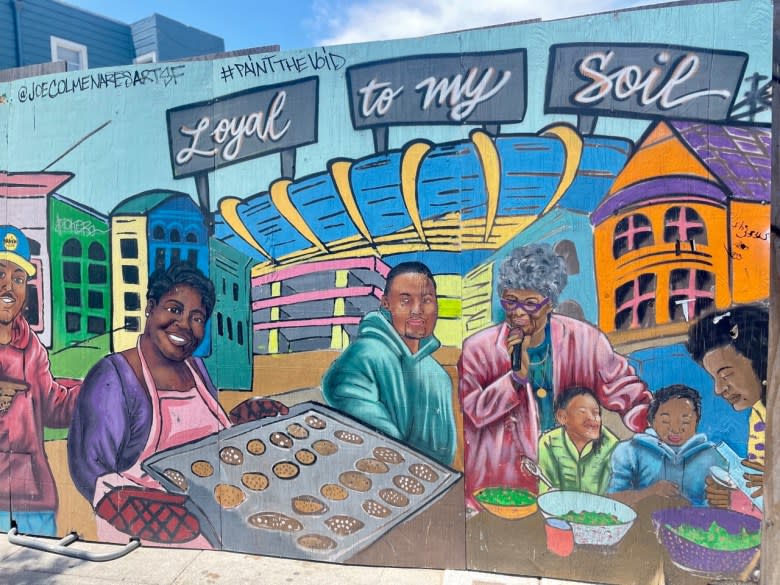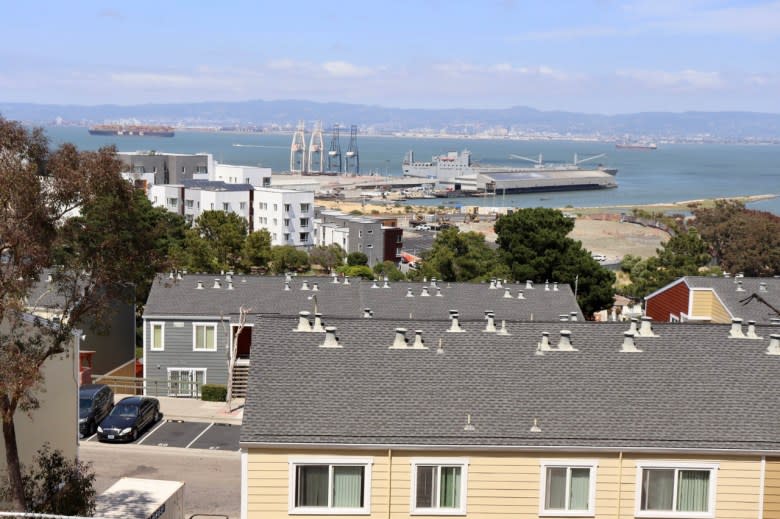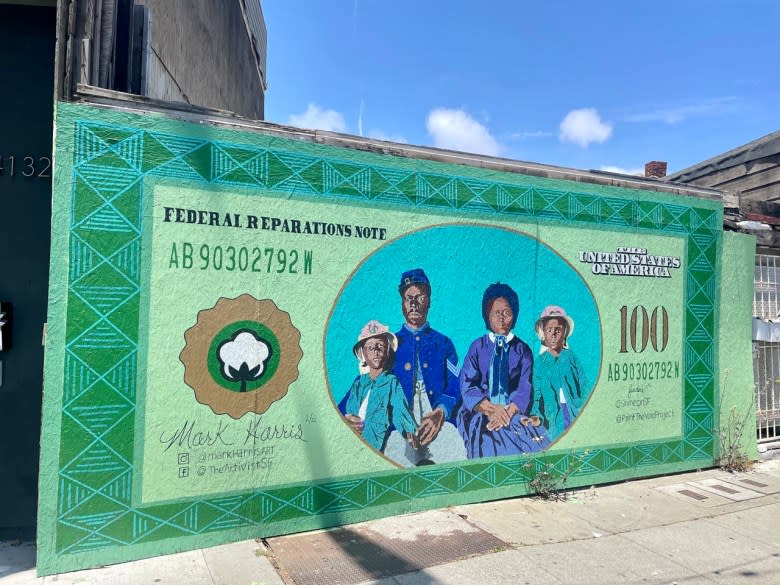The Last Black Neighborhood in San Francisco
SAN FRANCISCO — In November 1978, Pete Holmes was among the hundreds of Black San Francisco residents killed in one of the most notorious mass murder-suicides in history.
Three weeks later, Holmes’ granddaughter Kamillah Ealom was born in a San Francisco hospital more than 4,000 miles away from where her grandfather and others perished in the Jonestown Massacre in Guyana. In the decades since, his death has defined her life and how Black San Francisco is fading.
Some of her earliest memories come from watching her mother, Shirletha Holmes-Boxx, mourn those deaths.
“I was the young baby in the funeral home while they were receiving all the Black bodies,” she says, now 45 years old. “I lived through that pain. It became a part of me.”
But the tragedy isn’t the most damning disruption of Black life in San Francisco, Ealom says. It is only a speck on the score of scourges eroding the city’s Black community.
Since her birth, urban renewal, mass incarceration, and a subsequent tech boom have all but effectively erased entire family lines as the city’s Black population has declined by 60%.

Today, a singular Black neighborhood — Bayview-Hunters Point — remains in the city, one of the country’s 20 largest.
While the loss of Black residents appears as a stain of guilt for the city’s new, extremely wealthy class of residents and for local politicians, there isn’t any agreement on how to address it.
There was a twinkle of hope born out of the racial justice protests in 2020: a citywide task force for Black reparations. But then, last month, Mayor London Breed abruptly pulled the reparations office from the city’s budget. The day after her announcement, the federal government disclosed it had found more radioactive waste in Bayview-Hunters Point, where cancer clusters have taken out entire blocks.
In a statement to Capital B, the mayor’s office said, Mayor Breed “does not believe” the city needs a reparations office “to implement programs to benefit the African American community,” pointing toward her $60 million investment in the Dream Keeper Initiative “to address the disparities that San Francisco’s Black communities face.”
Still, the cascading revelations added to a long list of disappointments, Ealom says. And they underscore the realities that plague the city and a state that has bled hundreds of thousands of Black people over the past two decades.
Read more: Combating Climate Change Begins With Reparations, Bay Area Residents Say
Bayview-Hunters Point is at the center of an ambitious state plan to build 2 million new homes over the next decade — homes, Ealom and other residents believe, that aren’t going to be obtainable for Black people. A housing redevelopment in one of Los Angeles’ remaining Black enclaves led to similar fears.
But even if the homes were slated to serve struggling Black residents, she questions why having a roof over your head must come at a detriment to your health. In California, housing communities serving Black and Latino people are five times more likely than others to be located in proximity to toxic sites.
“Folks don’t understand the level of racism and inequality that we face every day of our lives being Black in liberal California,” she says.
The death of a Black neighborhood

To mark the first in-person meeting of San Francisco’s reparations committee, members felt they had no choice but to gather in the Fillmore district.
As the World War II wartime economy drew Black workers and the city’s Black population grew tenfold in the 1940s, the Fillmore became the center of Black life. For migrating Black Southerners, the allure of San Francisco and the Fillmore was not just access to stable government jobs but a humming jazz scene and the opportunity for community ownership in the “Harlem of the West.”
It’s what drew Ealom’s family from Texas. Despite rampant segregation, in the Fillmore, her great-aunt, Verdella Boxx, was able to open the city’s first Black beauty school. At the same time, her great-uncles and grandfather, Holmes, spent years working at a shipbuilding yard — the same one where new radioactive waste was just found.
Today, due to the city’s plan for “urban renewal”– or, as James Baldwin described it, “Negro removal” — there are a lot fewer jazz notes lingering in the air and even fewer Black people owning businesses.
Quite simply, the urban renewal process, which sprang across the country following the Civil Rights Movement, was an intense, government-facilitated version of gentrification. It entailed clearing out and demolishing Black neighborhoods within cities to make way for new freeways, businesses, and homes for wealthier, oftentimes white, people.
In the Fillmore, 75% of displaced Black residents never found housing and 96% of displaced Black businesses never reopened in the city again. It created the conditions that led to the Jonestown massacre, historians argue.
The white-led Peoples Temple, which ultimately facilitated the massacre, swooped in as Black San Francisco was reeling from urban renewal, attracting people like Holmes who lost their jobs and homes over the prior two decades and wanted to build a more equal San Francisco.
But the promise of racial solidarity and support for Black issues only ended in mass Black death.
The story of the Fillmore is woven through the city’s final reparations report that came out this past summer; Jonestown is glaringly missing.
Around the report’s release, Breed, the city’s second Black leader, promised to set aside $4 million to continue funding the work. When she backtracked in December, it felt reminiscent of how the promise of urban renewal ultimately led to the reality of Black displacement, Ealom says.
“They wonder why there are no Black people here, but the city that I’m born and raised in is a for-profit city — they’re not worried about Black folks.”
Refugees in their own home

For the Fillmore’s last Black residents attempting to hold on, grief made it hard to walk the neighborhood. The constant reminder of the Jonestown Massacre led to the rest of Ealom’s family moving to Bayview-Hunters Point, along with thousands of other Black Fillmore residents.
They left one toxic situation for another. It was punch after punch, Ealom recalls, from an onslaught of police brutality in the 1960s and ’70s to a rising drug epidemic and incarceration as she came into adulthood in the ’80s and ’90s. She spent some of this time in foster care as the “war on drugs” affected her family.
“The things that served the Black community were lost. Our middle-class jobs transitioned into service and janitorial ones before I had to watch all my brothers sell weed and dope because there were no jobs left,” she says.
“It felt like we were refugees.”
Read more: California’s Reparations Plan Exposes Deep Divides in Black Communities
All the while, the city’s remaining Black community contended with one of the nation’s worst environmental disasters, as elements of radioactive waste infiltrated the soil and groundwater underneath the community and power plants and warehouses polluted the air.
The pollution has reverberated across generations. “I lived my whole childhood in San Francisco General [Hospital], being an asthmatic,” Ealom recalls. Decades later, in 2022, a 2-year-old relative passed away from cancer. It inspired her retirement-age mother, Holmes-Boxx, to become an environmental community organizer.
“We always have to fight,” Ealom says.
The city’s reparations task force said it had ways to stop this carousel of harm.
Over the two years of its existence, the task force crafted more than 100 proposals to address how racism and the ghosts of slavery haunted Black residents, namely economic inequality. San Francisco has the nation’s third-highest income gap between the rich and the poor, with Black people having the city’s lowest average income.

Some proposals included offering down payment support, cleaning up toxic waste at Bayview-Hunters Point, creating a satellite HBCU campus, and, to the most ire from non-Black residents, $5 million in direct cash payments to each Black San Franciscan.
The city’s final reparations report received backlash from non-Black residents across the country, who viewed the proposals as a “political ploy.” Some said Black Californians did not deserve reparations because slavery was never legal in the state. (In the 19th century, illegal enslavement of Africans did persist in California, and the state legislature passed a bill that banned free Black Americans from migrating to the state.)
Some Black residents have viewed Breed’s removal of the office as an attempt to appease a growing faction of moderate San Franciscans who’ve popped up since the COVID-19 pandemic began.
Ealom applauded the proposals. While it wasn’t the most flashy, she was most excited about the prospect of an HBCU campus. She credits her HBCU education from Dillard University as the driving force behind her ongoing efforts to protect her home. “I wouldn’t have been able to fight or even know how to fight for my community without it,” she says.
But, as the city faces a $75 million mid-year budget pitfall, the idea of reparations was the first on the cutting block. (San Francisco is the 17th largest city in the U.S., but has the nation’s fourth-largest annual budget at more than $14 billion.)
The mayor’s office said instead of focusing on maintaining the city’s push for reparations, “we should be focusing our efforts on programs that impact the community.” As such, the effort to build 12,000 new homes in the city’s Black neighborhood remains a go.
However, without a focus on making Black communities whole and building up the social infrastructure around the housing, like cleaning up air pollution and bolstering schools and job training, Ealom says, the venture won’t mean much for the community.
At one point, dozens of members of Ealom’s family lived there.
“Only four of us survived through this suffocation. I’m only still here and alive because this intergenerational community raised me,” she says. “But all the Black kids left here don’t have that luxury.”
As the federal, state, and city governments work to mitigate the community’s toxic legacy for redevelopment, just over the last year, the neighborhood’s Black population has dropped by nearly a tenth.
The post The Last Black Neighborhood in San Francisco appeared first on Capital B News.

